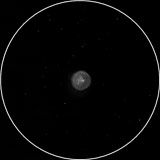
| 17P/Holmes |
|---|
Discovery date |
November 6, 1892. |
Discovered by |
Edwin Holmes |
Type |
short period comet |
Perihelion distance: |
2.053 AU |
Aphelion distance: |
5.184 AU |
Peak apparent magnitude: |
2.5 |
Lenght of tail: |
NA |
17P/Holmes is a periodic comet in our solar system, discovered by the British amateur astronomer Edwin Holmes on November 6, 1892. In only 42 hours in October 2007, the comet brightened from a magnitude of about 17 to about 2.8. This represents a change of brightness by a factor of about half a million and is the largest known outburst by a comet. On November 9, 2007 the coma, the thin dissipating dust ball around the comet, was found to be the largest object in the solar system, with a diameter greater than that of the Sun. Between October 23–24, 2007, Comet Holmes grew much brighter, going from about magnitude 17 to about magnitude 2.8 in just 42 hours. The first person reportedly to notice a change was J. A. Henríquez Santana on Tenerife in the Canary Islands; minutes later, Ramón Naves in Barcelona noticed the comet at magnitude 7.3. It became easily visible to the naked eye as a bright yellow "star" in Perseus and by October 25 17P/Holmes appeared as the third brightest "star" in that constellation. |
|
Comet |
|
After outburst comet was very bright. Coma was circular and rapidly expanding. Through 200mm telescope comet was round, bright and without color. Coma had brighter ring of material on her edge and core was starlike with fan shaped jet of material. Outstanding comet. |
|
29.10.2007. |
|
VEDRAN VRHOVAC© 2006.-2007. |
